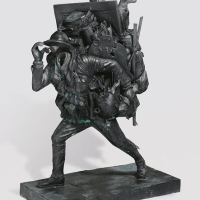54. TIM STORRIER

Banished for decades, the figure finally emerged in the art of Tim Storrier (born 1949) in an exhibition titled In Absentia, held at Australian Galleries, Sydney, in 2010. The figures were spectral entities given form by the clothes they inhabited and the accessories they sported. The sex, character and history of these figures was instilled into a series of intriguing paintings that became the foundation for Storriers future venture into large scale sculptural works. The artists forensic attention to form and space in a 2D format would open up opportunities to amplify his vision in a sculptural realm.
The catalyst for Storriers recent enterprise was his Archibald Prize-winning painting, The Histrionic Wayfarer (After Bosch) 2012. In a statement at the time, Storrier outlined the significance of the work: It refers to a painting by Hieronymus Bosch called The Wayfarer painted in c1510 where the figure is believed to be choosing a path or possibly the prodigal son returning, says Storrier. It also has other references, I believe, but they are rather clouded in biblical history and time.
Storriers bronze sculpture is, in fact, an accumulation of a lifetime of experience and associations. The most consistent element in Storriers evolution as an artist is his adherence to the value and integrity of memory. Growing up at Umagarlee, a 7000 acre property north-west of Wellington in the central-west of New South Wales would stir the nascent artists imagination. The bush in all its manifestations was his playground. The perforated iron sheds replete with kerosene lamps, bottles, old golf clubs, tools, leather harness, tin mugs and plates, canvas tarpaulins, chains, and rusting sections of fencing wire made up a visual language to be summoned later in the solitude of the studio. From the sheds, he would head off down dusty tracks and across dry creek beds to explore his domain. Military capers were a favourite pastimemaneuvering toy soldiers, overseeing battles, pitching tents and hoisting flags. Later in life, Storrier would come to grips with the horror and pathos of war. He recently noted that The Histrionic Wayfarer (After Bosch) could be viewed as an oblique parody on a war memorial.
In The Histrionic Wayfarer (After Bosch), the motif is deliberately mannered, emphasising the histrionic character of the Wayfarer. The metaphor suggests the cumbersome nature of an existence constantly hindered by the accumulation of possessions that can reduce the human enterprise to a farce: clarity of purpose is constantly diverted. As Storrier pointed out: A carapace of burden is depicted in The Histrionic Wayfarer, clothed in the tools to sustain the intrigue of a metaphysical survey. Provisions, art materials, books, papers, bedding, compass and maps, all for the journey through the landscape of the artists mind accompanied by Smudge, the critic and guide of the whole enterprise.
In early 2013, Storrier decided that he wanted to transfer the image of The Wayfarer into a 3D bronze. To achieve the exacting nature of Storriers vision in a large-scale sculpture, the artist underwent a lengthy process of investigation and collaboration. Storrier made numerous drawings that enabled artisans at the foundry to create the desired result in a 3D image. Eight maquettes were produced prior to casting the large-scale versions of the same subject of which five were created. The purpose was to refine the posture and detailed image of the object before proceeding to the larger sculpture. These maquettes display the meticulous detail of Storriers vision and the exhaustive craftsmanship involved in bringing his character to life.
Gavin Wilson and Caroline Jones